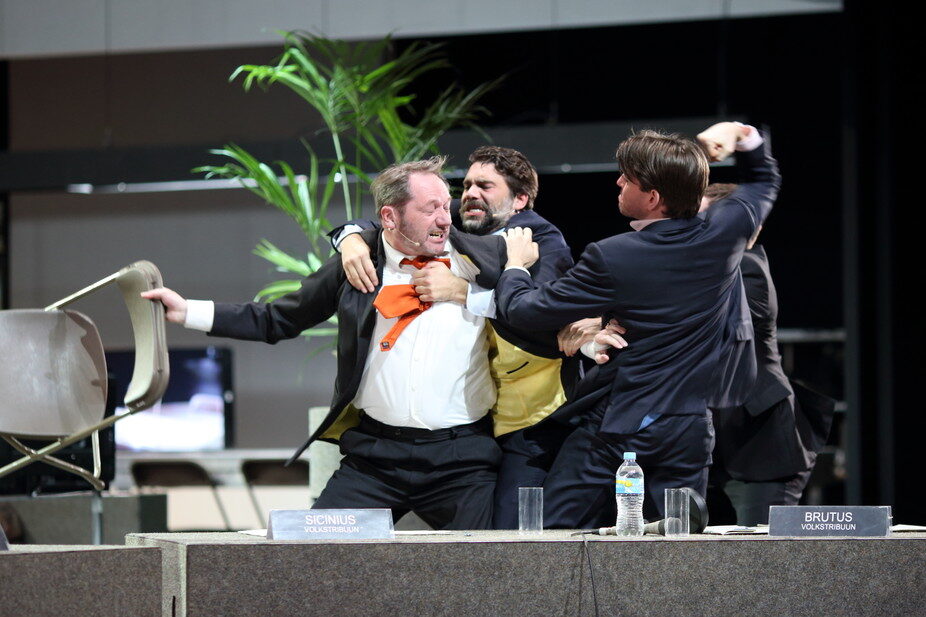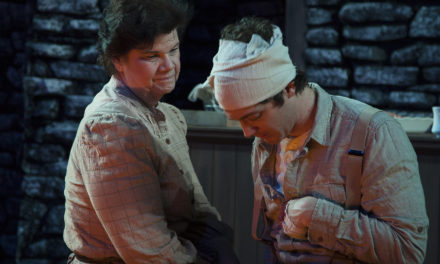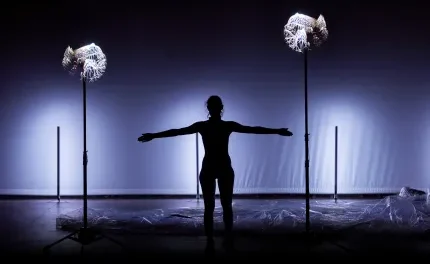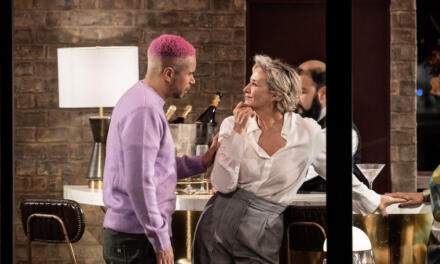Over six hours, three Shakespearean tragedies – Coriolanus, Julius Caesar, and Antony And Cleopatra – are connected in an immensely ambitious production, Toneelgroep Amsterdam’s Roman Tragedies. Under Ivo van Hove’s direction, this was one of the key offerings at the 2014 Adelaide Festival of Arts.
Roman Tragedies strips Shakespeare’s original plays of pretty well everything but their political content. The principal focus of this decidedly theatrical – and sometimes chaotic – production rests on the power struggles that began in the broader political arena of the Roman Republic and eventually led to the bloody birth of the Roman Empire.
Whether or not the staging of these three tragedies was a brilliant directorial coup – or little more than smoke and mirrors, bells and whistles – depends very much on where one stands in relation to Shakespeare’s original works. One’s attitude to Shakespeare’s use of language and how he might have understood the historical contexts of both ancient Rome and Elizabethan England are also relevant here.
And importantly, there’s the question of how much a director should mess with Shakespeare’s text. As one audience member whose tweet was displayed during the production quipped, “Ah, Brutus, get back to the text!”
Welcome to the stage
The mise-en-scène suggested the Roman Forum, in the guise of an airport, or perhaps the lobby of a five-star hotel. The stage was a kind of border zone where the audience was able to mingle, observe others, and freely come and go.
This setting enabled van Hove’s chief directorial intervention and dominant trope to be maintained throughout.

Roman Tragedies onstage. Photo Credit: Tony Lewis/ Adelaide Festival
The unfolding events onstage were portrayed as if they were part of a contemporary 24-hour news cycle. The audience could go onstage, move about, purchase and consume food and drinks while up there – or just sit on the capacious upholstered lounge suites watching or doing their emails.
The audience doubled as onstage extras, variably performing roles of plebeians or patricians. To accommodate the large number of extras onstage, the Toneelgroep actors performed some of the most significant scenes on elevated platforms, in a necessary and persuasive piece of staging.
Multimedia Shakespeare
Makeshift on-stage television studios popped up at intervals, with press conferences or interviews with newsreaders or the plays’ protagonists providing running commentaries on the action.
Huge plasma television screens, onstage and in the theatre foyer, drew loose parallels between the on-stage action and current events in global and local politics and daily life.
This included interpolating filmed sequences, mostly relating to war and bloodshed, with a few junk food and drink adverts, footage from the Sochi Winter Olympics, as well as footage from the forthcoming South Australian state government election.
At the same time, English surtitles back-translated the plays from the contemporary, vernacular Dutch language of this performance into clear although mostly rather prosaic English. These were intercalated with real-time breaking news and tweets by audience members.
At especially dramatic moments, a live percussion band mostly comprised of drums and cymbals created shattering, psyche-penetrating commentary. Onstage cameras filmed, and at times chased, the action, which in turn was live-streamed back to the audience.
At key moments close-up shots of principal players were streamed onto these large screens whilst they were actually speaking their lines.

Photo Credit: Tony Lewis/Adelaide Festival
Flawless performances
The acting of the majority of the players in Toneelgroep Amsterdam was beyond compare. Whether judged individually or as ensemble acting, most performances were flawless.
Frieda Pittoors, who plays Volumnia, was brilliantly controlled and understated as Coriolanus’s mother, a woman who has deliberately shaped her son into a machine of war. Gijs Scholten van Aschat as Coriolanus, gave a standout performance, and Hans Kesting, as Antony, received a rapturous reception from the audience.
Three tragedies
While Shakespeare’s Coriolanus was written later than his other two Roman tragedies, the Toneelgroep Amsterdam production begins with this play, opting for historical chronology in the events portrayed. To have played the three tragedies in the order in which they were written may have revealed more about the ways in which each play evoked – and indirectly commented upon – events and power-plays affecting Shakespeare and his contemporaries in Elizabethan England.
Coriolanus, an exploration of the life and death of the tragically proud and inflexible Roman General, Gaius Marcius (Martius in Shakespeare) Coriolanus, is, of all Shakespeare’s plays, including Hamlet, the one that focuses – arguably – most narrowly on a single character.
The critical relationship between Coriolanus and his mother Volumnia is well handled in this production, avoiding most of the excesses of a narrowly Freudian interpretation.
Coriolanus is followed by Julius Caesar, which portrays the conspiracy against Caesar, his assassination, and its aftermath.
This also is beautifully and compellingly acted, particularly when a number of his fellow politicians, fearing the advent of a dictatorship, decide to “remove” the Caesar in order to preserve their democracy. As a Shakespearean tragedy, the Toneelgroep production delivered with the first two plays.
There were some high points in the final “Roman Tragedy,” Antony And Cleopatra.
Playing Octavius Caesar as a tough, composed young blonde woman was an inspired piece of casting. But Antony And Cleopatra was where Roman Tragedies lost me.

Photo Credit: Tony Lewis/Adelaide Festival
Cleopatra’s gravitas and the potentially lethal power that she commanded were, in my view, compromised by her coquettish demeanor and highly mannered performance. This did not befit a tragic heroine. When she screamed like a banshee at her loss, she also seemed to lose regal dignity.
While there are comic elements in many of Shakespeare’s tragedies, it is a mistake to play them for laughs. For example, playing Antony’s new wife Octavia (who he marries for strategic reasons) as a rather dim gum-chewing ingénue, bordered upon travesty.
This was a fault in the direction, in which the two lead parts especially were represented almost soap operatically. The Shakespearean tragic hero, always a person of high estate, is brought down not only by his or her own tragic flaws but also by fate. In this production, Antony and Cleopatra were (almost) reduced to a celebrity political power couple relationship in the manner of François Hollande and Valerie Trierweiler. Up until that point, the metaphor of the 24-hour news cycle worked well.
Perhaps the ultimate reductio ad absurdum of the Roman Tragedies’ dominant news-cycle metaphor could be seen in this representation of Antony And Cleopatra.
Yes, Cleopatra is histrionic and vain – but she is not trivial. Cleopatra is a dangerously powerful woman and regent, imbued with tragic grandeur. This production denied her of such essential dimensions, which meant that at times Antony and Cleopatra teetered on the brink of farce.
It brought to mind Karl Marx’s famous appraisal of Napoleon I and his nephew Napoleon III, in The Eighteenth Brumaire of Louis Bonaparte:
“history repeats itself, the first time as tragedy, the second time as farce.”
Toneelgroep Amsterdam’s Roman Tragedies played at the Adelaide Festival March 1st and 2nd, 2014. Full details here.
This article was first published on www.theconversation.com. Reposted with permission. Read the original here.
This post was written by the author in their personal capacity.The opinions expressed in this article are the author’s own and do not reflect the view of The Theatre Times, their staff or collaborators.
This post was written by Christine Judith Nicholls.
The views expressed here belong to the author and do not necessarily reflect our views and opinions.


















